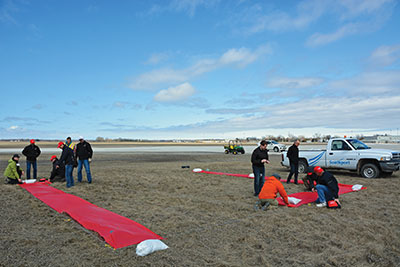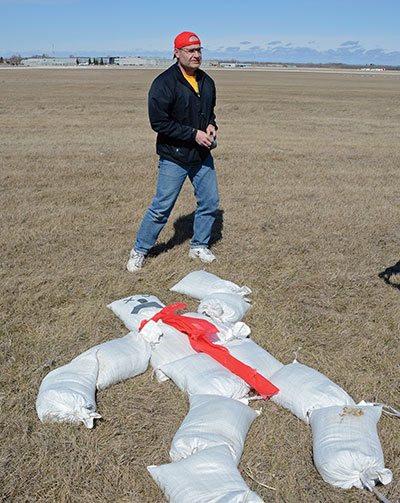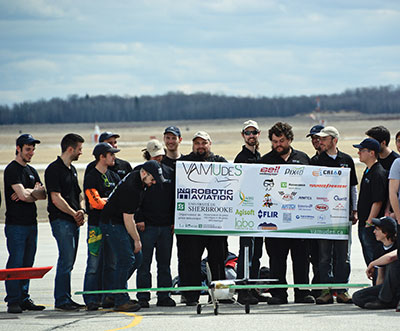
Features
Drones
The quest to own the skies
Three days in May saw a human whirlwind of activity touch down at Southport, outside Portage La Prairie, Manitoba.
September 8, 2014 By Paul Dixon
Three days in May saw a human whirlwind of activity touch down at Southport, outside Portage La Prairie, Manitoba.
 |
|
| Team VAMUdeS, Unversite de Sherbrooke, walking its aircraft out to the runway. PHOTO: Paul Dixon
|
More formally known as the 2014 Unmanned Systems Canada Student UAS Competition, it was a showcase for the future of unmanned aviation in Canada. Eleven teams and more than 90 students turned out for the competition, the largest turnout to date. The first student competition took place in 2007, in military air space at Goose Bay, Labrador with the team from Universite de Sherbrooke taking top prize. The leader of that Sherbrooke team, Charles Vidal, is now Chair of the Organizing Committee for the USC Student Competition.
The competition continued as a biannual event, in 2009 at CFB Gagetown and 2011 at CFB Val Cartier, but as interest grew, changes had to be made, as recalled by USC Past Chairman and President of Montreal-based Xiphos Systems Corp., Eric Edwards.
“We realized that by flying in military air space, there were two things that were holding us back,” Edwards said. “One, Transport Canada was getting comfortable with us doing this in simplified air space situations and we realized we could push the acceptance of these systems into Canadian air space by moving our competition into shared civic air space. The other change came from the students themselves. They told us they wanted to see accelerated development, and to do that, they needed more continuity and they needed to hold the competition every year, not every two years. Doing it every two years you lose the thread of the team, you lose the technology, you lose the whole teamwork element. We realized that we needed to do it in the same place every year or at least limit the number of places. We held a national competition and the winner was Southport, so in 2012 we came back to Southport. A close second was Alma, Quebec and we took it there in 2013. We’re back in Southport this year, we hope to go back in Alma next year and we’d like to keep alternating between the two sites.”
This year’s competition was scheduled to run over a three-day period, with Friday and Saturday for preparation and practice flights and with the money run on Sunday. Unfortunately, Mother Nature wasn’t included in the planning, as southern Manitoba was slowly recovering from the harshest winter on record. Visitors were advised the week before the competition that there was still snow on the ground in many areas, though hopefully it would be gone from the competition area. Luckily, the snow was indeed off the ground, but the wind blew non-stop on Friday and Saturday – gusting at times to gale force – wreaking havoc on several teams that braved the elements. It simply added another challenge to the competition.
A strategic alteration
A major change in 2014 saw the competition change from a technically driven competition to a business-driven challenge. Teams were presented with a course laid out between the airport runways that represented a farmer’s field, an oil pipeline and a landslide debris field that they would be required to reconnoiter. On the Friday morning, teams were also required to make their business pitch to a committee, detailing a strategic plan for each scenario. On Sunday, each team had 45 minutes to conduct their flight, collect their data, and from the end of their allotted flight time, 60 minutes to collate their data into a finished report. But their score wasn’t based on the design and performance of their aircraft or the sophistication of their sensors and technology. It was based on the quality of the contractor report that would be delivered to the clients who had contracted them to do the work.
 |
|
| The Dronolab quadcopter returning from its training flight. Photo: Paul Dixon
|
The featured speaker at the Friday evening reception was Doug McDonald, Director of Special Projects at the Unmanned Applications Institute International, based in Grand Forks, North Dakota. McDonald was unable to appear in person, as he was dealing with the last-minute details in preparing for the official launch of Grand Sky the following Monday. He was, however, available via a Skype video link.
“Six weeks ago we were notified by the Federal Aviation Administration (FAA) that we would be the first site (UAV and UAS development site) to be activated,” McDonald told the student competitors. “We’ll be the FAA guinea pig. This has been a long process and it doesn’t happen overnight. On Monday, we start our first sorties using Draganflyers. We’re hoping to parlay that into fixed wing and a series of ‘next steps’ across the board, both in size and duration.”
Grand Sky is a 217-acre site, co-located with the Grand Forks Air Force Base. The site offers almost one million square feet of hangar and building space to companies that will be involved in UAS testing, development, training repair and maintenance as well as sensor technology and systems development. McDonald is bullish on the future of unmanned aircraft.
“This is going to be huge,” he said. “Our organization predicts that once they are allowed to fly in the national airspace there will add $82 billion to the national economy, with 100,000 new, high-paying jobs. With the sensor payloads and the small UAS, which will be the focus of our work here, the challenges are there for students. The opportunities are unlimited.”
While much of the focus on unmanned systems in the U.S. has been on military applications, McDonald sees Grand Sky’s mandate to drive the commercial possibilities, such as precision agriculture, pipeline patrols along with FEMA and public safety. The location of the site will also benefit Canada. “We have signed an MOU with Southport, and we hope to do some cross-border initiatives focusing on the same things – precision agriculture and some of the common interests on both side of the border,” he said.
Grand Forks Air Force Base had been slated for closure, but thanks to a united front from local, state and federal representatives, the air base lives on. The B-52s and tankers are gone, but they have been replaced by the Predators and Global Hawks operated by Homeland Security and the North Dakota Air National Guard. Operating the Grand Sky site within the security provided by the air base is an extra incentive for potential tenants such as Northrup Grumman and Rockwell Collins.
McDonald also discussed the level of frustration some in the industry have with current U.S. regulations prohibiting the operations of UAVs in commercial air space. While the FAA has been directed to address the issue by September of this year, McDonald does not see that happening. The situation in the U.S. has many commercial operators moving ahead without authorization and operating under the FAA regulations for radio-controlled hobby aircraft (under 400 feet and away from airports or “sensitive” areas).
 |
|
| The quadcopter used by Team Dronolab from Ecole de Technologie Superieur was the only rotary UAV in the competition, but the team was able to fly it effectively in the high winds. Photo: Paul Dixon
|
At the conclusion of McDonald’s presentation, Edwards took the opportunity to reiterate the differences between American and Canadian regulations. The USC competition takes place in civil airspace, not military air space. Every student team had to apply for its own SFOC, and USC applied for an overarching SFOC covering the entire competition – all is on paper, all above board.
McDonald offered a closing comment on the difference in dealing with U.S. and Canadian regulators. When Canadians complain about having to deal with Transport Canada, he asks them how long it takes to get an approval. The response is generally in the order of a couple of weeks, which makes him chuckle. “We’re lucky,” he says “if we get a simple yes or no answer in less than six months.”
Grand Sky is pressing ahead to address the same challenges that faced the student teams at Southport – precision agriculture, the oil and gas industry and public safety issues. McDonald concluded by saying, “the real focus (of the site) is on research and development. The initial research focuses are system safety and aircraft certification, command and control links, ground and airborne sense and avoid. That’s the mission put forth by the FAA. Then we need to move forward into actual intelligence – turn data into intelligence for a myriad of end users and clients.”
The grassroots perspective
Vidal was the team leader of the Universite de Sherbrooke team that won the first student competition back in 2007. Today, he is the Director of Solutions at ING Robotics of Montreal. Talking with the media about this year’s competition, he said the scenarios were designed to illustrate the challenges the Canadian unmanned
systems industry faces.
 |
|
| USC volunteers attempting to lay out the course were hampered by high winds. Sandbags were required to keep the plastic sheeting in place. Photo: Paul Dixon
|
“Students have to design, build and operate their unmanned aircraft in support of agriculture, mining and oil and gas industries,” he said. “Excluding the military, the three main industries are agriculture, mining and oil and gas. The military talks about 3D (dull, dirty and dangerous), but in the commercial world we think of MIM – mapping, inspection and monitoring – because we think these are the three key things that unmanned aircraft can provide. Being able to survey a field with a UAV will enable a farmer to spot problems earlier and take remedial action.
“For open pit mines and quarries, UAVs offer the ability to quickly and accurately map inventories and stockpiles. The oil and gas industry needs to patrol pipelines to detect leaks as quickly as possible and also to determine if there is encroachment on rights of way.”
 |
|
| Marc Sharpe drew on his years of forensic training to create an extra target for the course. Photo: Paul Dixon
|
Speaking from his own experience, he described the importance of student competition. “They work for a year to design their systems, sometimes as part of their courses, sometimes it’s extracurricular. Some teams build their own aircraft, others buy the aircraft and design all the electronics. It gives them work experience and credibility for when they look for jobs. Going to university is not just about the grades, it’s also being able to do something.”
It takes a wide range of skill sets to make a successful UAV team, he added. Mechanical engineering, software engineering, computer engineering are all paramount, as unmanned aircraft are a mix of mechanical, electrical, software, and firmware. Sound program management and fundraising ability are also critical. “It’s a multi-disciplinary thing,” he said.
Another objective of the competition is to make people aware that this technology exists,” Vidal said. “It’s not science fiction, it’s here, it exists and it’s available,” he said. “We want to make people aware that there are all these Canadian universities and students working to develop the next generation of flying robots. We believe this is a truly excellent student engineering competition and they are trying to solve real problems.”
Dealing with Mother Nature
An extra dose of reality was provided during the competition by the wind that blew non-stop throughout Friday and Saturday. It grounded most practice flights and caused the organizing committee to do a quick re-think of the ground targets. The targets were to be defined by sheets of bright red plastic held in place by tent pegs. Unfortunately, the wind quickly separated the plastic from the pegs. The only solution at hand was to anchor the targets with sandbags, with the result that actual targets, while spread out across a great distance, were smaller than originally planned. Winds gusting above 60 kilometres-an-hour played havoc with the few teams that ventured out.
 |
|
| The 2014 Unmanned Systems Canada Student UAS Competition winners – Team VAMUdeS from the Unversite de Sherbrooke. Photo: Paul Dixon |
Team Dronolab from Ecole de Technologie Superior in Montreal, managed to fly both of its quadcopters on the Saturday afternoon, reportedly the first time two aircraft had flown under one SFOC. The quads appeared to handle the winds with little problem, but the constant auto-correction drained the batteries, cutting flight time by half. Battery life was a topic of conversation with all teams and is a limiting factor in the development of commercial applications. Another problem teams faced was radio interference with control systems from a variety of sources – other teams and even airport tenants.
The forecast for Sunday morning called for a break in the wind. Flight schedules were moved up to sunrise in order to give teams enough time to get a second flight in if problems arose with the first. The competition called for 45 minutes of airtime, followed by 60 minutes to develop the report and submit it to clients. There were plenty of highs and lows on the flight line, but when it was over, the top teams were able to put their aircraft in the air, fly their routes and bring them back without significant drama.
USC Chairman Stewart Baillie, speaking at the awards ceremony said it was an impressive competition to watch, “the cutting edge of technology at the student level. The competition is about rising to the occasion and innovating new solutions.” Speaking as one of the “clients” who sat through the student deliverables, he congratulated teams that had gone above and beyond – those that added value to their reports by adding more information than a client required. With tongue planted slightly in cheek, he gently admonished one team that offered a full refund when their flight aborted due to the weather conditions. “Read the fine print in your contract before you do anything like that,” he said smiling.
It was very intense competition for students, with plenty of late nights and little sleep. For most, the competition came on the heels of final exams. For industry representatives in attendance it showcased some of the bright minds of tomorrow operating under very stressful conditions. And then there was this stark reality as well: no matter how sophisticated technology becomes, when you absolutely have to get the job done, duct tape is still the answer.